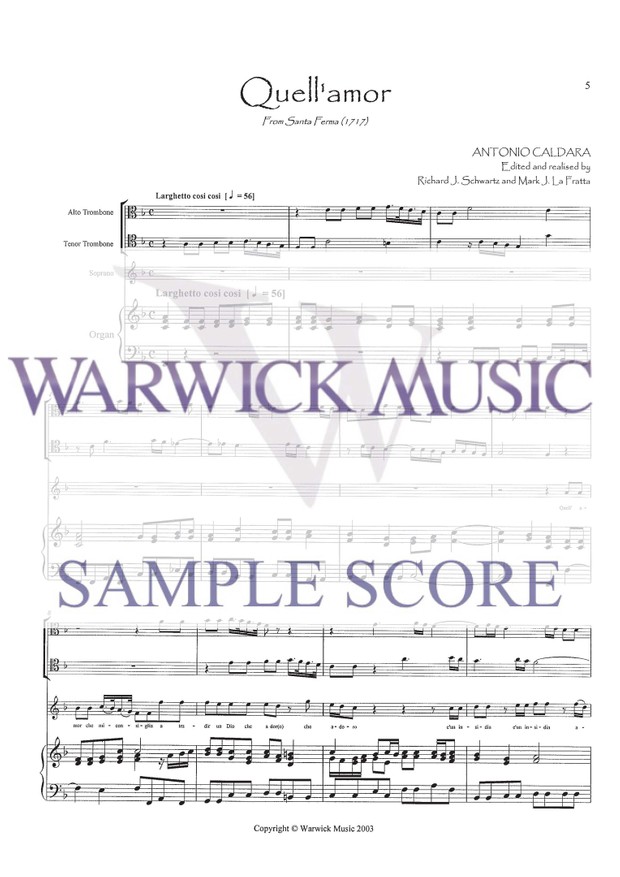£4.99


Caldara: Quell'amor from Santa Ferma (1717) - Alto Trombone, Tenor Trombone, Soprano & Keyboard
To download the sample score click on the link below
https://warwickmusic.egnyte.com/dl/UXBLjhZnAq/TB676_sample_score.pdf_
Antonio Caldara (b Venice, c1670; d Vienna, 28 December 1736) began his career in the choir at St. Mark’s, Venice, becoming proficient on viol, cello, and keyboard. He then worked for the Duke of Mantua between 1699 and 1707 as maestro di cappella da chiesa e dal teatro. From 1709 to 1716 he worked in Rome for Prince Ruspoli as maestro di cappella. From 1716 until his death Caldara worked as vice-Hofkapellmeister in Vienna. His works include over 3,000 compositions, mainly vocal ones, one of the largest outputs of his era.
This aria, Quell’amor, is taken from Santa Ferma, composed in 1717. A typical Viennese "Sepolcro", it was one of dozens of such works commissioned by the Austrian Habsburg royal family for a Holy Week performance during the culmination of Lent leading to Easter. These Sepolcro were generally one-act oratorios. Frequently occurring at the high theological point in the Sepolcro, there is a solo aria with trombone obbligato, representing the voice of God. These works were called "Sepolcro" as they were to be staged in front of a replica of the Holy Sepulchre (i.e. the tomb of Jesus in Jerusalem) temporarily constructed in one of the Royal chapels. They were always based on Biblical texts, but were also considerably expanded into a type of musical passion play. Often, as is the case with Quell’amor, they told an Old Testament story, but were enfleshed by including New Testament implications. The text reads: "Quell'amor che mi consiglia a tradir un Dio adoro e un insidia, amor non e no, no amor non e. Io mio scordo d'esser figlia e me'e lieve ogni martoro per serbar a lui la fe." Translated, the text becomes "That love which counsels me to betray a God I adore is a trap. Love it is not. No, no, Love it is not. I forget myself to be [his] daughter and it softens me towards every torment to put aside the faith in him."
Quell'amor was written for three soloists, i.e. two trombonists and one singer, and as a result could easily be performed in an informal setting or in a more formal one, perhaps in church or on a recital. There were no figured bass symbols in the original manuscript. The only alteration from the manuscript was to place the soprano voice in treble clef, a consideration made for the sake of modern performance. Both alto and tenor trombone remain in their respective clefs.
More information on Caldara and his use of the trombone in Viennese oratorios can be found in Stewart Carter's article entitled "Trombone Obbligatos in Viennese Oratorios of the Baroque" in the Historic Brass Society Journal (vol. 2 [1990]: 52-77); in Joyce L. Johnson and Howard E. Smither, eds., La decollazione di San Giovanni Battista [by] Antonio Maria Bononcini [and] La Passione di Gesù Christo Signor Nostro [by] Antonio Caldara, introductions by Howard E. Smither (New York: Garland Publishing, 1986); and in Ursula Kirkendale, Antonio Caldara: Sein Leben und seine venezianish-römischen Oratorien (Wiener Musikwissenschaftliche Beiträge, Graz: Herman Böhlaus Nachf., vol.6, 1966). The original manuscript for the complete oratorio can be found at the Österreichische Nationalbibliothek, Vienna (Mus.Hs. 17.089).
SKU: TB676
Composer: Antonio Caldara
Arranger: Ed. Dr. Mark J. La Fratta; Realized by Dr. Richard I. Schwartz
Difficulty: Intermediate
Instrumentation: Alto Trombone; Tenor Trombone; Soprano; Keyboard ()
Range: Bb3-Bb4; F3-Bb4



